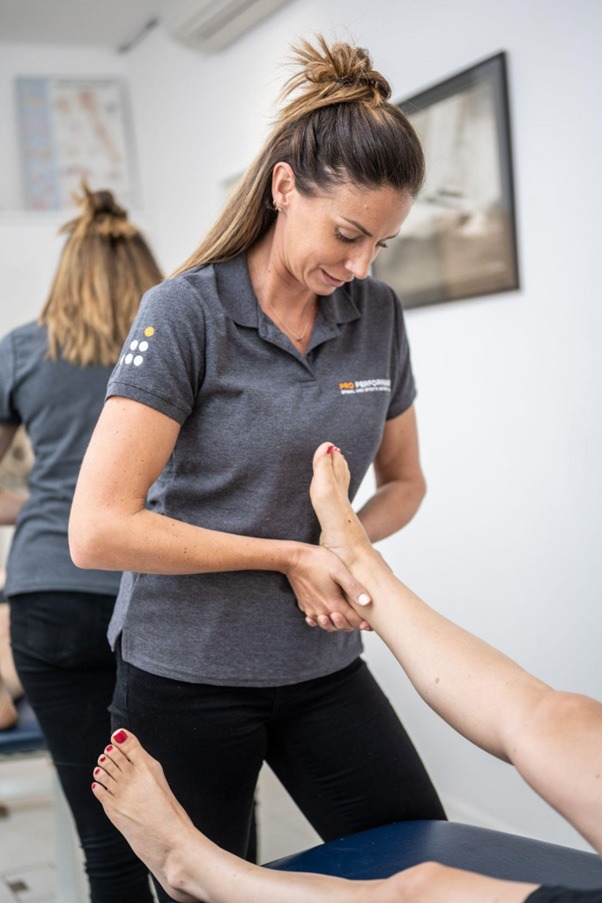
Plantar fasciitis is one of the most common running injuries we treat at our Notting Hill W8 and City of London EC3 Chiropractic and Osteopathy Clinics.
Here we are going to fully explain what this incredibly common condition is, plus how we fix it using our combination of advanced treatment techniques and corrective exercises.
What is Plantar Fasciitis?
Plantar fasciitis is irritation of the soft tissue underneath the sole of the foot (called the plantar fascia). This strong band of tissue becomes inflamed and injured after it is overloaded with mechanical stress, such as running too far.
Where does plantar fasciitis hurt on the foot?
The fascia is most commonly irritated at the heel or middle of the foot, although pain can sometimes be felt up to the base of the forefoot.
How does plantar fasciitis develop?
Plantar fasciitis develops when you have faulty biomechanics and run too far, too fast or too often for your plantar fascia to stay healthy. We call this “failure to repair”.
A classic example that we see is people training for the London marathon without planning their training schedule properly. They start by running too far, too fast or too often, which means their plantar fascia fails to repair sufficiently between each run and then the injury occurs.
Will my plantar fasciitis go away?
Plantar fasciitis will rarely go away by itself. The problem is that most people have a biomechanical problem that needs to be fixed before they can start running or walking normal distances again.
What biomechanical issues cause plantar fasciitis?
Overpronation/Flat feet – Weak muscles within the glutes and foot arch can allow the medial foot arch to flatten, causing excessive strain on the plantar fascia.
Unsupportive footwear – Footwear with a small toe box or lack of cushioning can cause more pressure to be placed on the plantar fascia.
Leg length difference – If you have one leg longer than the other or a twisted pelvis, this can cause more weight to be loaded onto one foot and increase the chances of injury.
Can plantar fasciitis be cured?
Yes absolutely! With the correct treatment and rehab program, plantar fasciitis can be successfully treated in most of our patients.
Are plantar fasciitis socks effective?
In our experience, plantar fasciitis socks aren’t a very effective treatment because they don’t address the underlying issues that cause the overload of the fascia in the first place.
Are plantar fasciitis and heel spurs the same?
No, although you can have both at the same time!
Heel spurs form when the plantar fascia tugs at the heel bone and a small spur of bone grows outwards in response to traction.
What to do when plantar fasciitis won’t go away?
Shockwave therapy is the best option when plantar fasciitis doesn’t respond to manual therapy and rehab techniques. We have a state-of-the-art Chatanooga Mobile 2 RPW shockwave machine at our Notting Hill W8 Chiropractic and Osteopathy Clinic.
Why does plantar fasciitis usually occur in one foot?
Normally due to a musculoskeletal imbalance such as a leg length difference or a twisted pelvis. This causes extra pressure to be placed on one foot.
Will plantar fasciitis come back?
Yes, if you don’t address the underlying cause of the plantar fasciitis
How is plantar fasciitis diagnosed?
A clinical exam and case history is sufficient for 99% of people. In rare cases, an ultrasound scan can be useful to differentiate between plantar fasciitis and other conditions of the foot.
Who treats plantar fasciitis, a chiropractor, osteopath, physio or podiatrist?
Well that’s quite simple…us! Our chiropractors and osteopaths are trained to not only treat the plantar fasciitis, they are exceptional at treating the underlying causes of the pain too.
How do you treat plantar fasciitis?
At Pro Performance our Notting Hill and City of London Clinics, we treat plantar fasciitis using a unique combination of advanced modern treatments and corrective exercises.
Firstly, we treat the pain using sports massage and dry needling on the plantar fascia and dry needling on the surrounding muscles to release the tension. In severe cases, we may use a pair of orthotics to allow the plantar fascia to rest sufficiently.
Then we address the underlying cause of the condition. For example, by using spinal manipulation to rebalance the pelvis or corrective exercise to strengthen weak glute muscles etc etc.
Over the last 15 years, we have helped hundreds of patients in our London Chiropractic and Osteopathy Clinics recover from plantar fasciitis for good!